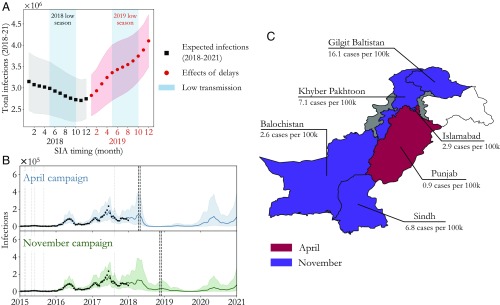Fig. 3.
Optimizing SIA timing in Pakistan. (A) Comparing total expected infections in 2018–2021 (black, SE shading) under different SIA policies shows that November minimizes measles burden by taking advantage of susceptible buildup over the low-transmission season (blue region). As a result however, delays into the 2018–2019 high-transmission season (red, SE shading) are costly. (B) Model projections for pre– (April) and post–low-transmission season (November) SIAs (black dashed lines) demonstrate the tradeoff between 2018 and 2020 outbreak control. As a result, 2017 measles burden also plays a significant role in timing optimization. (C) Extending the model to the province level allows us to compare April and November SIA timing subnationally. Preference for April is mapped in red while preference for November is mapped in purple; gray provinces [Federally Administered Tribal Areas and Azad Kashmir, representing less than of Pakistan’s total population (20)] are inaccessible to health workers while white areas indicate disputed territory. Heterogeneity in the 2017 laboratory-confirmed measles cases per 100,000 (indicated) is reflected in the timing optimization.

